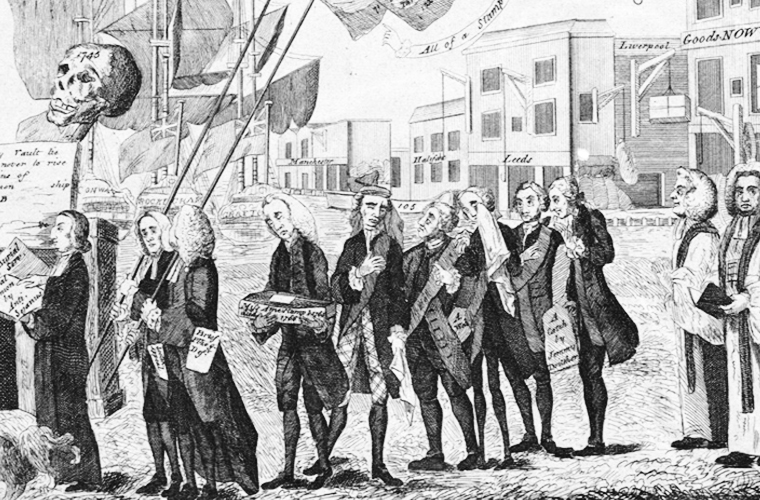The Stamp Act of 1765 was the first internal tax levied directly on American colonists by the British government. The act, which imposed a tax on all paper documents in the colonies, came at a time when the British Empire was deep in debt from the Seven Years’ War (1756-63) and looking to its North American colonies as a revenue source. Arguing that only their own representative assemblies could tax them, the colonists insisted that the act was unconstitutional, and they resorted to mob violence to intimidate stamp collectors into resigning. Parliament repealed the Stamp Act in 1766 but issued a Declaratory Act at the same time to reaffirm its authority to pass any colonial legislation it saw fit. The issues of taxation and representation raised by the Stamp Act strained relations with the colonies to the point that, 10 years later, the colonists rose in armed rebellion against the British.
The Seven Years’ War (1756-63) ended the long rivalry between France and Britain for control of North America, leaving Britain in possession of Canada and France without a footing on the continent. Victory in the war, however, had saddled the British Empire with a tremendous debt. Since the war benefited the American colonists (who had suffered 80 years of intermittent warfare with their French neighbors) as much as anyone else in the British Empire, the British government decided that those colonists should shoulder part of the war’s cost.
Did you know? Stamp Act opponent Patrick Henry is known for his “Give me liberty, or give me death!” speech, delivered before a meeting of Virginia’s colonial leaders in 1775 in an effort to mobilize a militia against a possible attack by the British. He later served as Virginia’s governor (1776-79, 1884-86). Instead of levying a duty on trade goods, the Stamp Act imposed a direct tax on the colonists. Specifically, the act required that starting in the fall of 1765, legal documents and printed materials must bear a tax stamp provided by commissioned distributors who would collect the tax in exchange for the stamp. The law applied to wills, deeds, newspapers, pamphlets and even playing cards and dice. Part of the revenue from the Stamp Act would be used to maintain several regiments of British soldiers in North America to maintain peace between Native Americans and the colonists. Moreover, since colonial juries had proven notoriously reluctant to find smugglers guilty of their crimes, violators of the Stamp Act could be tried and convicted without juries in the vice-admiralty courts.
The colonists also took exception with the provision denying offenders trials by jury. A vocal minority hinted at dark designs behind the Stamp Act. These radical voices warned that the tax was part of a gradual plot to deprive the colonists of their freedoms and to enslave them beneath a tyrannical regime. Playing off traditional fears of peacetime armies, they wondered aloud why Parliament saw fit to garrison troops in North America only after the threat from the French had been removed. These concerns provided an ideological basis that intensified colonial resistance.
Parliament pushed forward with the Stamp Act in spite of the colonists’ objections. Colonial resistance to the act mounted slowly at first, but gained momentum as the planned date of its implementation drew near. In Virginia, Patrick Henry (1736-99), whose fiery orations against British tyranny would soon make him famous, submitted a series of resolutions to his colony’s assembly, the House of Burgesses. These resolutions denied Parliament’s right to tax the colonies and called on the colonists to resist the Stamp Act.
Newspapers throughout the colonies reprinted the resolutions, spreading their radical message to a broad audience. The resolutions provided the tenor for the proclamations of the Stamp Act Congress, an extralegal convention composed of delegates from nine colonies that met in October 1765. The Stamp Act Congress wrote petitions to the king affirming both their loyalty and the conviction that only the colonial assemblies had the constitutional authority to tax the colonists.
While the Congress and the colonial assemblies passed resolutions and issued petitions against the Stamp Act, the colonists took matters into their own hands. The most famous popular resistance took place in Boston, where opponents of the Stamp Act, calling themselves the Sons of Liberty, enlisted the rabble of Boston in opposition to the new law. This mob paraded through the streets with an effigy of Andrew Oliver, Boston’s stamp distributor, which they hang from the Liberty Tree and beheaded before ransacking Oliver’s home. Oliver agreed to resign his commission as stamp distributor.
Similar events transpired in other colonial towns, as crowds mobbed the stamp distributors and threatened their physical well-being and their property. By the beginning of 1766, most of the stamp distributors had resigned their commissions, many of them under duress. Mobs in seaport towns turned away ships carrying the stamp papers from England without allowing them to discharge their cargoes. Determined colonial resistance made it impossible for the British government to bring the Stamp Act into effect. In 1766, Parliament repealed it.

